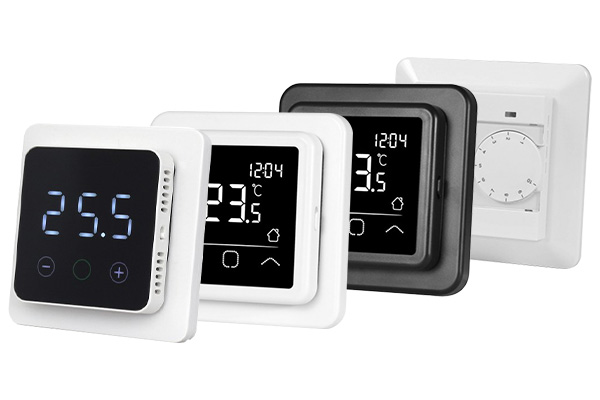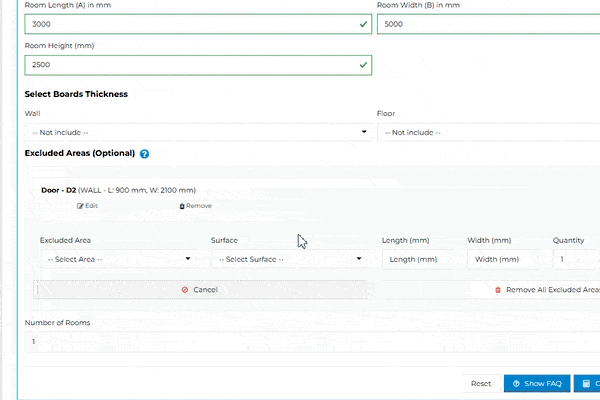Underflor heating calculator
Stay Warm with Ease – Underfloor Heating Calculation Simplified
Our Underfloor Heating Calculator is designed to help you plan the ideal heating solution for any room, whether you’re upgrading an existing floor or setting up a new one. Choosing the right thermostat, power requirements, and heating mats can feel complex, especially with safety and energy efficiency considerations in mind. Our calculator streamlines this process, using the room’s dimensions and layout to provide precise recommendations for thermostats, mats, and other components.
Perfect for various floor types, the calculator tailors its advice to projects involving entirely new flooring or simple overlaying on existing surfaces. By automatically factoring in essential considerations, like avoiding heating under large furniture or fixtures, you’re assured optimal warmth and performance, without wasting energy.
The tool is designed to be user-friendly and requires only basic information about your space. With just a few clicks, you’ll receive a detailed, custom plan for your heating needs. From room-specific thermostat recommendations to total power requirements, the calculator outputs everything you need, complete with a shopping list ready for purchase or download.
For added flexibility, you can download the plan as a PDF for easy reference, consultation, or to finalize an order with confidence.
Underfloor Heating Options Explained

Mat Heating
Mat underfloor heating is ideal for wet areas or rooms where new flooring is being installed. The mats are embedded within the tile adhesive or floor leveling compound, providing efficient and even heating across the floor. This option is particularly suitable for bathrooms and other high-moisture areas.
Foil Heating
Foil underfloor heating is a thin heating solution that does not significantly increase floor height. It is best for floors that are already installed, like wooden panels, where only a finishing layer will be added. This type of heating can be used under laminates and carpets, offering a versatile option for existing floors.


Thermostat Options
Selecting the right thermostat is crucial for maximizing the efficiency of your underfloor heating system. The calculator suggests the appropriate thermostat based on your room configuration, heating requirements, and preferences. Smart thermostats, like the SUNFLOOR Smart WiFi Digital Thermostat, provide advanced control and scheduling features to optimize heating and reduce energy consumption.
Excluded areas
To ensure optimal heating performance and avoid wasted energy, underfloor heating should not be placed under standalone elements like a bath, sink, or large furniture. Excluding these areas prevents overheating and helps the heating system function efficiently. Underfloor heating elements should be avoided under areas where baths, sinks, or other large fixtures are placed.

Understanding Your Calculator Results
When you use our Underfloor Heating Calculator, you’ll receive a detailed summary that includes essential information to guide your installation process:
- Heating Area: The total area that will be heated, automatically adjusted to exclude any specified non-heated zones such as spaces under furniture or fixtures.
- Product Recommendations: Suggestions for the best-suited heating mats or foil options based on your specific room configuration and requirements.
- Power Output: An estimate of the total power required to heat the area effectively, ensuring efficient and comfortable warmth.
- Thermostat Recommendations: The ideal number and type of thermostats for precise and flexible temperature control across different rooms or zones.
- Cost: An approximate total cost based on your selected products and room dimensions, giving you clear budgeting guidance.
Our calculator makes it easy to plan and gather all the necessary materials for your underfloor heating installation, so you’re fully prepared to create a cozy and efficiently heated environment.
Advantages of Installing Underfloor Heating
- Quick and Versatile Installation: Our underfloor heating systems can be adapted to any room layout, ensuring seamless coverage in any space, whether large or small.
- Smart Temperature Control: Advanced thermostats allow for precise temperature control, so your floors are warm exactly when you want them to be, maximizing comfort and efficiency.
- Energy-Efficient Heating: By operating at lower temperatures compared to traditional radiators, underfloor heating consumes less energy while delivering consistent warmth, reducing both energy usage and heating costs.
- Space-Saving Solution: Free up wall and floor space by eliminating the need for radiators, giving you more flexibility in arranging furniture and a cleaner, more attractive room design.
Why Choose Our Underfloor Heating Solutions?
Our electric underfloor heating products are carefully designed to warm both your floors and rooms, offering a powerful and convenient solution for any project. Whether you’re installing heating mats for tiles or foil heating under wood or laminate, our systems prioritize ease of installation and reliable performance. This tool helps you calculate, select, and plan your project, ensuring you have all the right materials for a successful installation.
What Is Electric Underfloor Heating?
Electric underfloor heating is an energy-efficient, easy-to-install solution that evenly spreads warmth throughout your home or business, even during the coldest months. In addition to enhanced comfort and aesthetic appeal, it offers the safety and control that modern homes require. This heating method operates without the need for extensive renovations, making it a popular choice for both new builds and upgrades.
Read our Underfloor Heating Guide for more insights and installation tips.
How Does Electric Underfloor Heating Work?
Electric underfloor heating operates with ultra-thin heating elements or mats installed beneath your floor covering. Connected to the mains electricity, these elements generate warmth that radiates evenly through the floor, maintaining a consistent and comfortable room temperature. The thermostat then allows you to set and control the desired temperature, ensuring efficient and reliable heating that’s tailored to your needs.
Underfloor heating - Frequently Asked Questions
Can the heating mat be cut to fit?
No, the mat size must match the heating area and be used fully. Cutting the heating cable will damage the system and void the warranty. If you have excess mat, you can unclip and re-lay the heating cable closer together, but the spacing between loops should not be less than half the original distance. Ensure cables never cross or touch each other.
Can the heating film be trimmed?
Yes, the heating film can be cut at designated points along the roll, usually every 20 cm. This flexibility makes it easier to match room dimensions without compromising functionality.
Where should I use heating film versus a heating mat?
Heating film is best suited for dry installations under wooden or laminate flooring. Heating mats are ideal for embedding within screed or tile adhesive for tiled floors. They can also be installed under vinyl, microcement, or resin flooring if embedded in a suitable layer.
Can the power and sensor cables be shortened or extended?
Yes, both the power supply cable for the heating mat and the floor sensor cable can be shortened or extended, provided you use the same cable diameter and type.
What is the maximum load for a thermostat?
The recommended maximum load for a single thermostat is up to 3500W, which covers around 23 m² of heating area. For larger areas, you can divide them into zones or use a relay switch to control a single thermostat over a larger area. Consult an electrician for specific installation needs.
Can one thermostat support multiple floor sensors?
No, each thermostat can only handle one floor sensor. Most thermostats include an internal temperature sensor as well, providing dual temperature control options.
Do I need a thermostat for the heating mat?
While a thermostat is not mandatory, it is recommended. A thermostat allows you to regulate temperature, save energy, and prevent premature wear. Without one, the mat will run constantly, which can be costly and inefficient.
Can mats from multiple rooms be controlled by a single thermostat?
Without additional electrical components, it’s not feasible. Consult an electrician for solutions if you require unified control across multiple rooms.
Can I connect multiple mats to a single thermostat?
Yes, multiple mats can be connected if their combined power does not exceed 3500W. It’s best to connect the mats in an electrical junction box and then run a single line to the thermostat. Consult an electrician for specifics.
How should I enter room dimensions?
Enter the full room dimensions where underfloor heating will be installed. You can then specify areas to exclude, such as space under fixed appliances. The actual heating area will be calculated automatically and reduced by 5% for safety. Suggested products will be displayed based on the result.
What areas should I exclude?
Provide dimensions for fixtures that cover the floor or sit on legs less than 10 cm high, such as bathtubs or washing machines. Excluding these areas prevents energy loss and overheating of the heating cable.
What thermostat options are available?
Thermostat quantity is calculated to match the heating power, ensuring a maximum load of 3500W per thermostat. Options include digital thermostats with remote app control or simpler thermostats without a display. A floor sensor is included with each thermostat. You can also choose just the heating mats if you already have a suitable thermostat for 16A single-sided electric heating mats.
Can I use a single thermostat for a large heating area?
Yes, with the addition of a suitable electrical relay switch to extend the thermostat’s load capacity. Consult an electrician for advice on setting up and wiring the system for larger areas.
What are popular heating mat sizes and configurations?
Popular configurations vary depending on room layout and coverage needs. Smaller rooms may use compact mats under 10 m², while larger, open spaces can benefit from full-room heating setups requiring mats up to 20 m².


